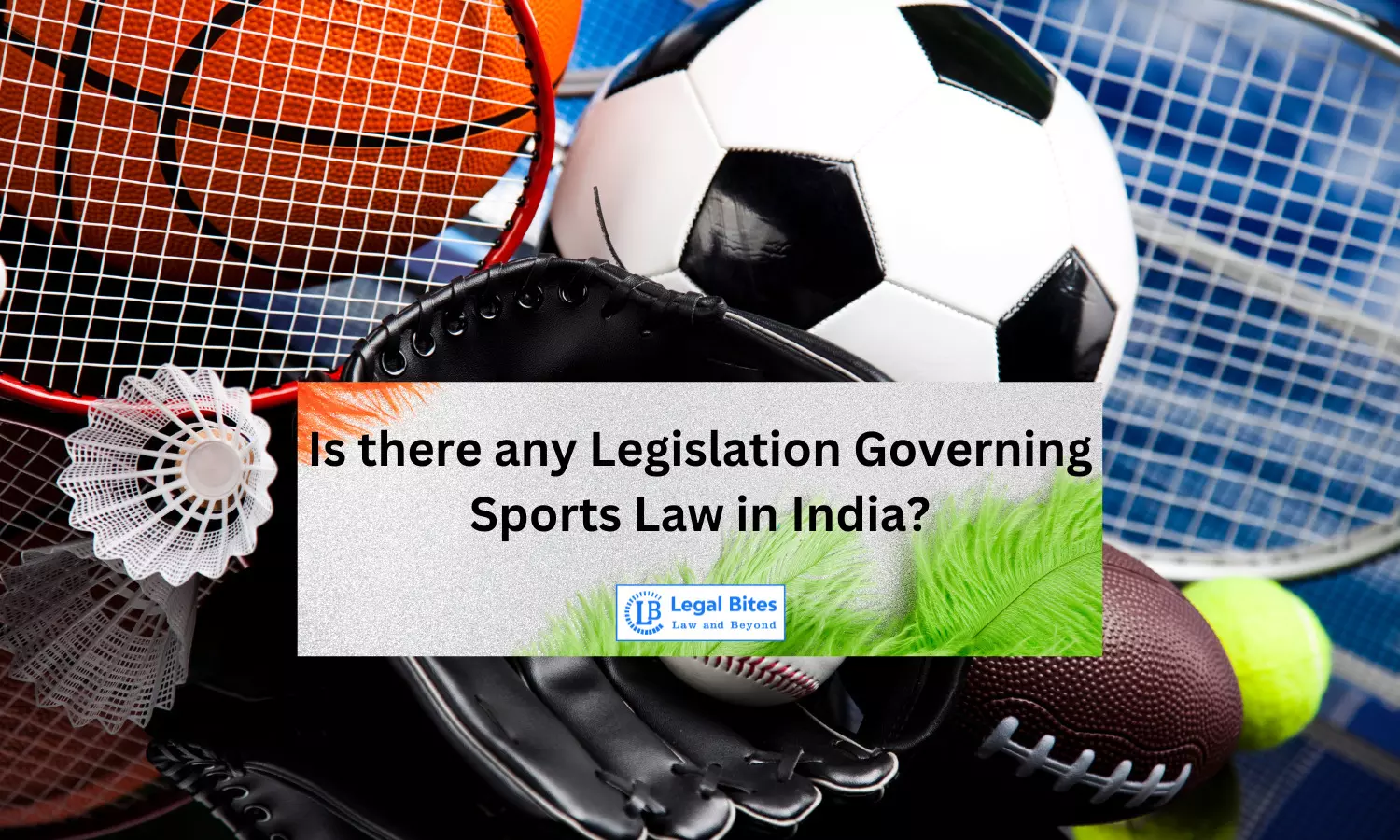Is there any Legislation Governing Sports Law in India?
The article 'Is there any Legislation Governing Sports Law in India?' analyzes the status of sports law in India.

The article 'Is there any Legislation Governing Sports Law in India?' by Radhika Mittal analyzes the status of sports law in India. The primary question that this article solve is whether India has any sports law or not. The article brings into the picture the historical background of sports in India, the associations that govern the sports, the legal mechanism to solve the disputes related to sports, and lastly, the suggestions for incorporating the laws of the sport. Sports are integral to human development. It is part and parcel of the human lifestyle. Sports governance and legislation, therefore, hold an important place for the protection and promotion of the sports industry in India. The author concludes that a robust law in sports is the need of the hour for our Country.
Introduction
Sports laws are those rules and regulations that govern all matters related to professional athletes. Various laws are prevalent in the sports industry, like personal injury, contract, criminal, and trademark laws. However, there is no single specific law that governs sports wholly in India. Indian laws on sports are scattered.
The Constitution of India prescribes the jurisdiction of the state government to make laws pertaining to sports under Entry 33 of the State List in the Seventh Schedule of the Constitution of India. However, this ambit of state government jurisdiction is limited to only a particular state and sports being played at national and international level finds it difficult to ascertain its regulatory mechanism. Sports in India, therefore, remains at the cornerstone for such Disputes That Remained Unsettled.
Historical Background
Sports law holds a historical significance in India in the sense that earlier, it was used as a means of recreation, fitness, defence, and attack and now, in the present times, it is used as a means of promoting national sovereignty, competition, and growth of physique. India is considered a source of many indoor games like chess which, according to Thomas Hyde was invented in India in 500 CE from where it reached China as described in the famous book of Marvels. Similarly, Polo, Archery, Hockey, and Wrestling are also among those sports which originated in India.
The inception of sports can be traced from the initialization of human civilization. The reference to sports can be seen in Mahabharata, Ramayana, Vedas, and the early human civilization like Harappan Civilisation, Indus Valley Civilisation, etc. Despite such a glorious past of sports in India, the reality at present time is altogether different.
Various Associations that Govern the Sports Law
In India, the Ministry of Sports and Youth Affairs governs the department of sports in India with the primary objective of developing the personality of youth and involving them in nation-building. The administration of sports is done by several autonomous self-governing regulatory authorities:
1. The Sports Authority of India (SAI)
The Sports Authority of India is the apex body of sports at the national level in India. It was established in the year 1982 and is a successor organization of the IXth Asian Games that was held in New Delhi in 1982. It is set up as a society that is registered under the Societies Registration Act, of 1860. It functions under the Ministry of Sports and Youth Affairs of the Government of India. The Sports Authority of India was established to serve the following objectives:
- Promoting sports
- Achieving sporting excellence at the national and international levels.
- Support training with scientific and sports equipment and scientific personnel.
- Maintenance and upgradation of 4 stadia complexes and a shooting range
- To implement various schemes of the Ministry of Sports and Youth Affairs like Khelo India, TOPS, FIT India, etc.
2. Indian Olympic Association (IOA)
Indian Olympic Association was founded in the year 1927 with the sole purpose of governing the Olympic movement and commonwealth games in India. It is registered as a Non-Profit Organisation under the Societies Registration Act, of 1860. It governs the sports and athletes' welfare in the country. It is recognized by the Ministry of Sports and Youth Affairs. Indian Olympic Association is an affiliated member of the following:
- International Olympic Committee (IOC)
- Commonwealth Games Federation (CGF)
- Olympic Council of Asia (OCA)
- Association of National Olympic Committee (ANOC)
3. Sports Law and Welfare Association of India (SLAWIN)
Sports Law and Welfare Association of India is a non-profit, national professional organization whose common goal is the understanding, advancement and ethical practice of sports law in India for the promotion of sports by bringing legal practitioners and sports persons together. Sports Law and Welfare Association of India aims at achieving the following goals:
- To provide educational opportunities and disseminate data and information about specific areas of sports law.
- To provide a forum for lawyers to represent various persons and organizations associated with sports.
- To promote and establish rules of ethics for sports.
- To address the issues of discrimination in sports.
4. National Sports Federation of India (NSFOI)
There are 56 recognized National Sports Federation of India. It is registered under the Indian Government Trust Act to serve the following objectives:
- Promote the fundamental principles of sports at the national level within the framework of sports.
- Development of athletes and sports for all programs.
- Training of sports administrator by organizing educational and sports programs.
5. National Anti-Doping Agency (NADA)
National Anti-Doping Agency was established in the year 2005. It is a national organization that is responsible for promoting, coordinating, and monitoring the doping control program in sports in all its form in India. It works on the vision of "Dope Free" sports in India. National Anti-Doping Agency's primary function is to:
- Adopt and implement anti-doping rules and policies.
- Cooperate with other sports-related organizations and anti-doping organizations.
- Encourage reciprocal testing between national anti-doping organizations.
- Promote anti-doping research and education.
The Legal way of Resolving Disputes Related to Sports
Although blanket legislation for resolving disputes is absent in India, there are certain authorities and methods through which a legal dispute with regard to sports could be solved. Such methods and recourse are:
Court of Arbitration for Sports (CAS)
The Court of Arbitration for Sports was set up in the year 1983 by the International Olympic Association (IOA) to provide an arbitration mechanism for resolving disputes in the sports arena. It is considered the "Sports Supreme Court of the World". Any nation which is aggrieved by any illegality of sports activities anywhere in the world may approach the Court of Arbitration for Sports for redressal.
Indian Court of Arbitration for Sports (ICAS)
The Indian Court of Arbitration for Sports was set up in the year 2011 by the Government of India to provide an alternative dispute resolution mechanism outside the courtroom to sportspersons for resolving disputes in the best possible way.
Sports Authorities
Various Sports Authorities like the Sports Authority of India (SAI), Hockey India (HI), BCCI, National Sports Federation of India (NSFAI), etc, hear and settle disputes related to sports in their respective jurisdiction. They settle the dispute in accordance with the guidelines that are mentioned under the rules of the organization.
Suggestions
Because of the absence of specific legislation concerning sports in India, many problems are borne out that remained unresolved. There is an imminent need to bring umbrella legislation that covers every aspect of sports activities in India. Apart from this, the subject of sports should be included in the concurrent list instead of the state list so that both the centre and the state can legislate on the matter of sports by keeping their respective jurisdiction conscious.
Steps must also be taken to promote and awaken the importance of sports in one's life. This can be done by setting up associations at the grassroots level so the sports infrastructure may be available to them. Most of the population of India lags because they do not have a proper sports infrastructure that allows them to showcase their talent and develop in the field of sports.
An association should also be created at each level and in each sport that handles the funds of the sports because a large proportion of funds received from the government remained in the hands of few people because of a lack of accountability.
Conclusion
India, being an originator of many sports, is lagging in the current times because of the shifting of focus from sports to academics. Sports is meagrely limited to the only grassroots level of Indian society, where small kids are enthusiastic about sporting, but they do not reach the national level because of poor sports infrastructure. It is high time that the promotion and prevalence of sports are required to stand in the international community. A robust law in sports is the need of the hour that governs, protects, and promotes all matters relating to sports in India.
References
[1] The Constitution of India, Available Here
[2] Societies Registration Act, Available Here
[3] Sports Law & Welfare Association of India, Available Here
[4] National Ant-Doping Agency, Available Here
Important Links
Law Library: Notes and Study Material for LLB, LLM, Judiciary, and Entrance Exams

